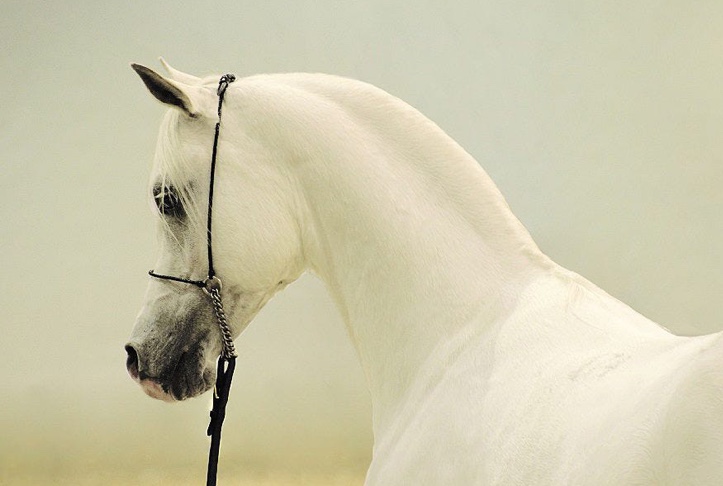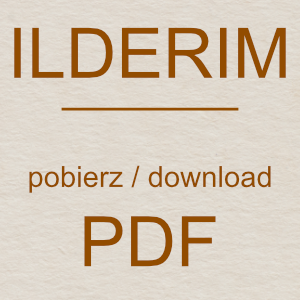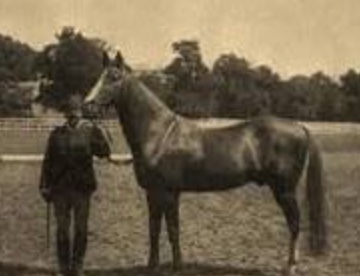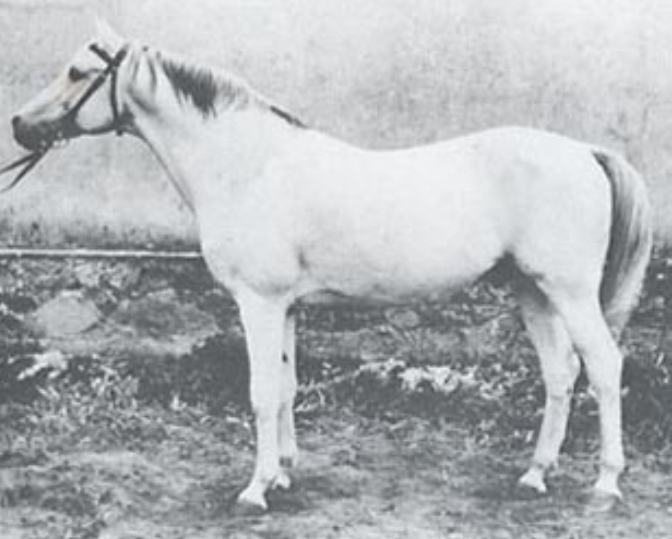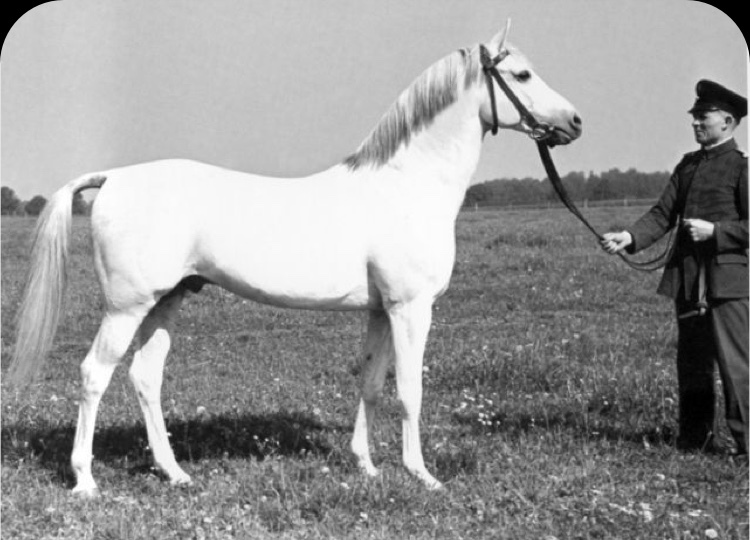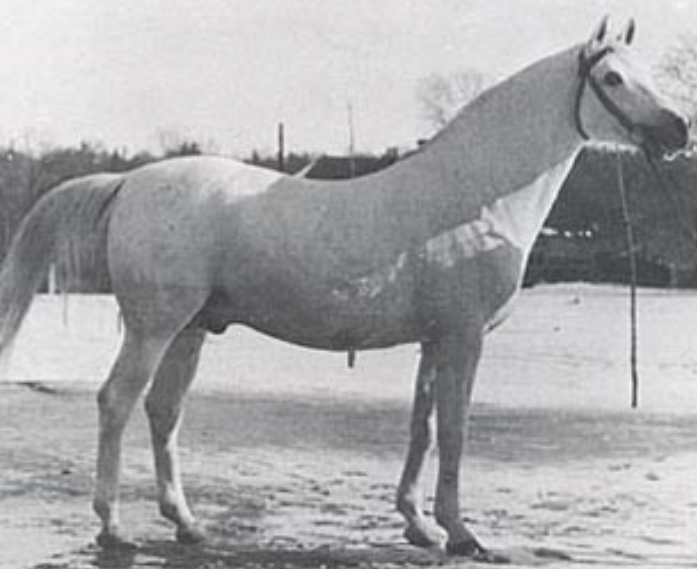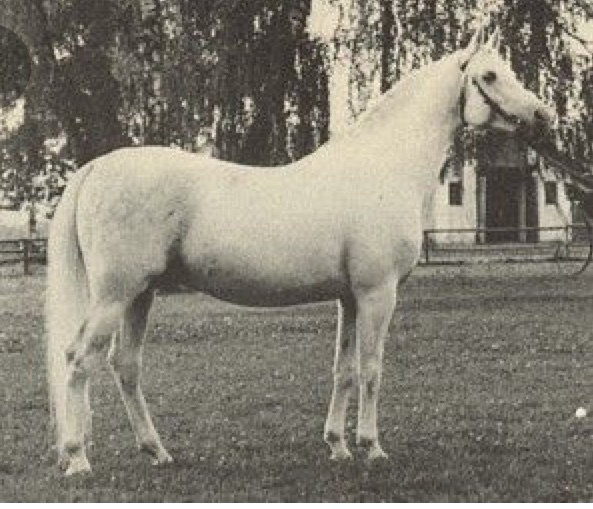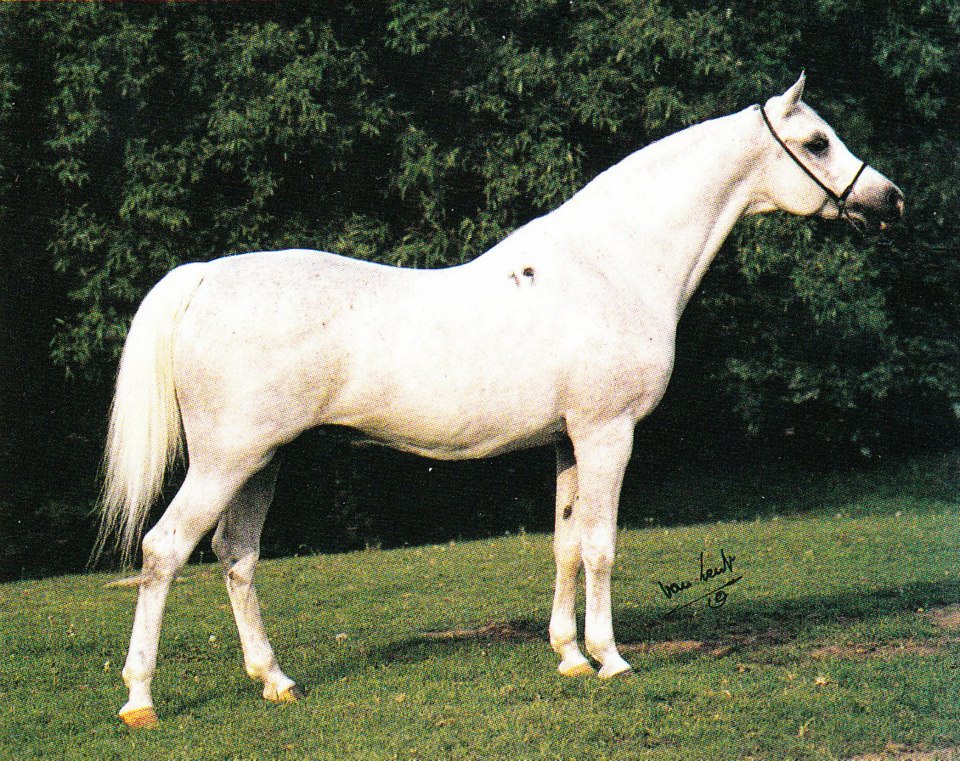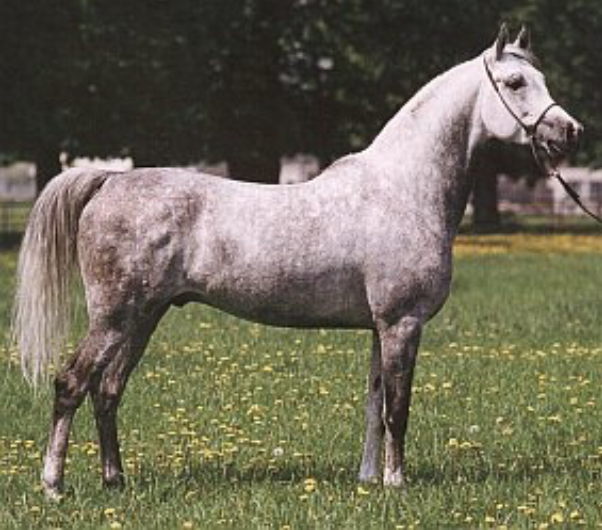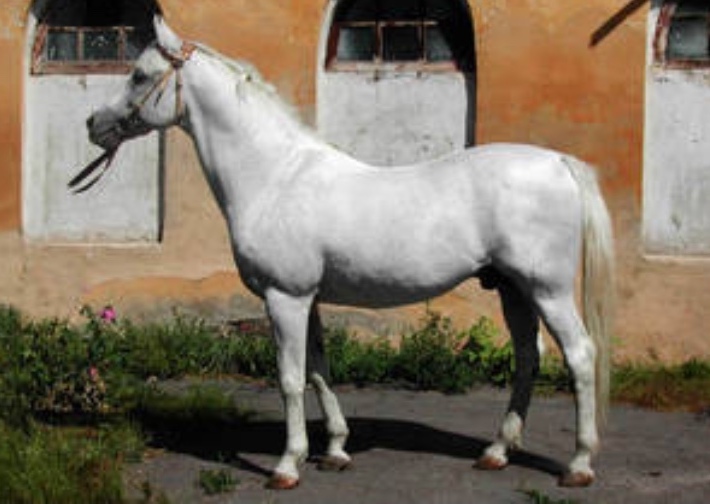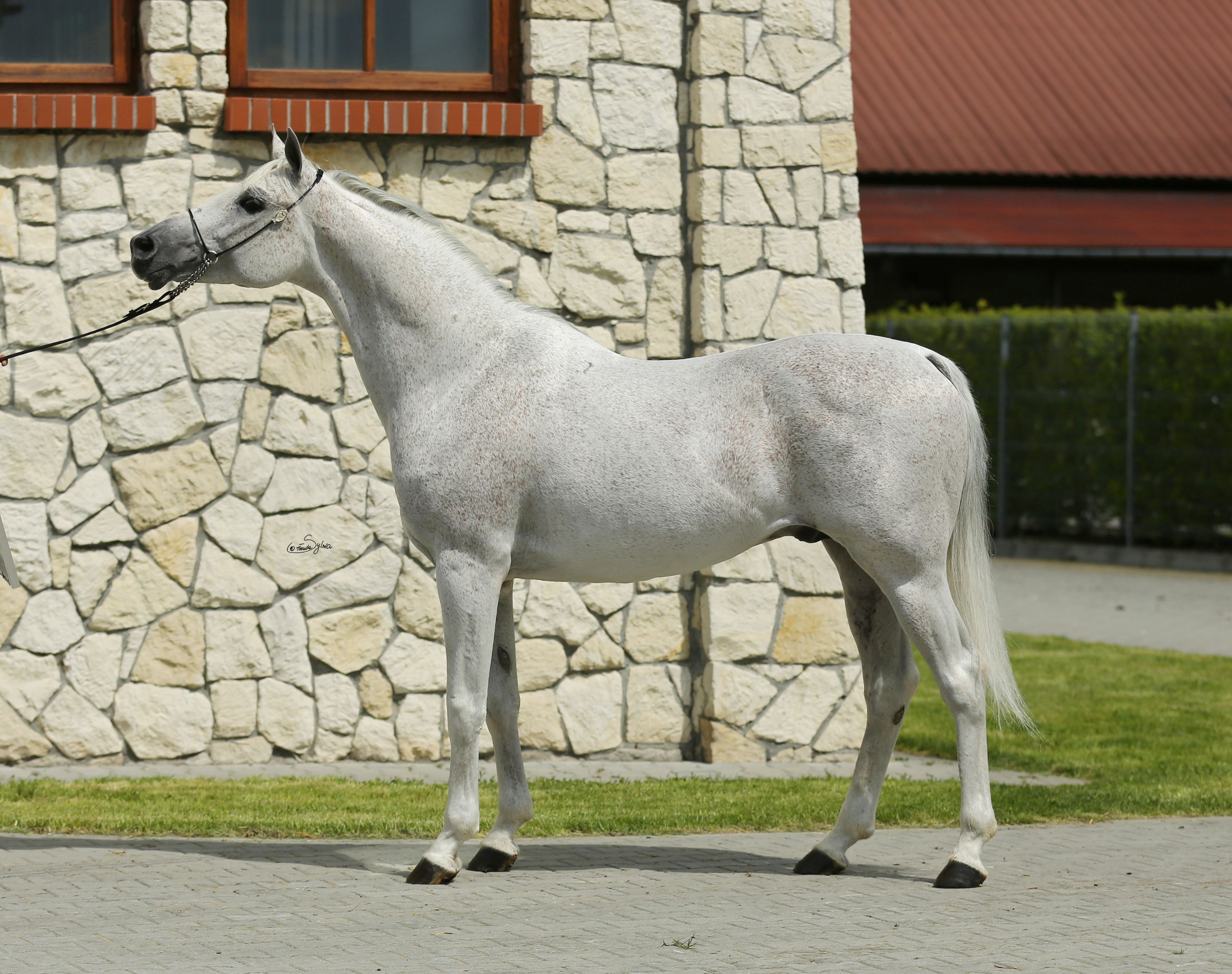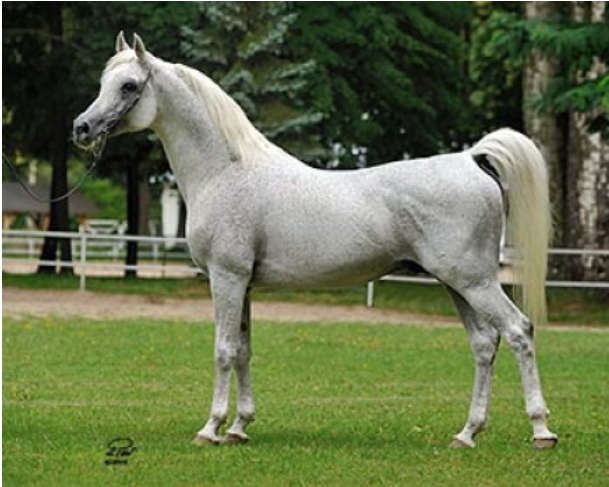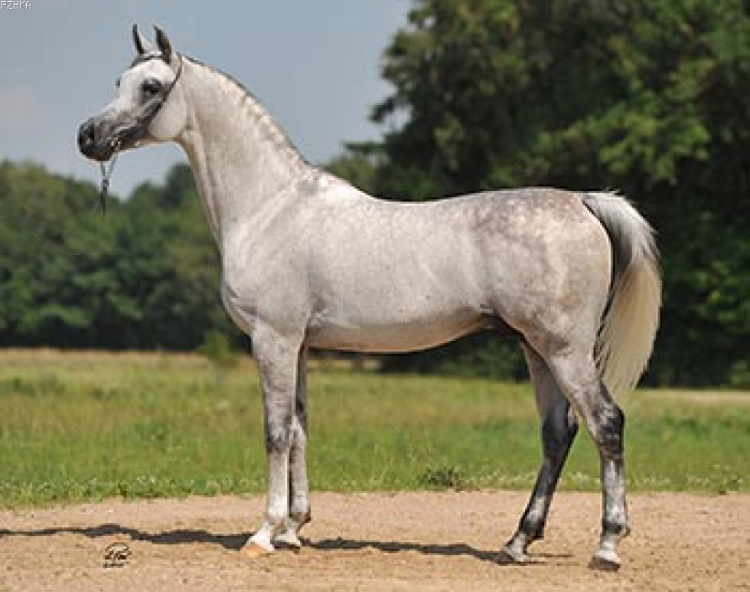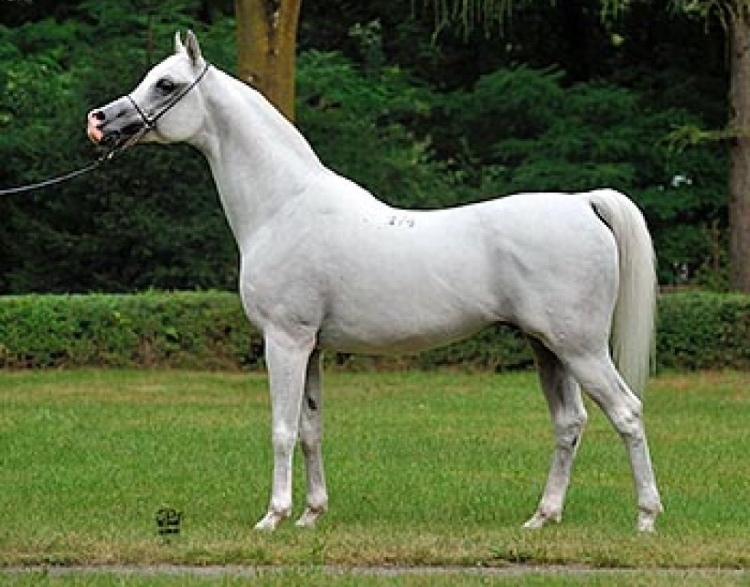SIRELINE ILDERIM d.b. 1894 imp. 1900 Sławuta
Palatino
2004 (Pesal-Palmeta by Ecaho) bred in Janów Podlaski, photo kasiaszr, source
fivehundredpx
The most valuable of the Polish borderland
studs, Sławuta, where the documented breeding of pure Arabian horses was conducted since 1799,
regularly imported horses from the East.
From
1804, when the documents were preserved, until the end of the stud's existence in 1917, 73 stallions
and 9 mares were imported to Sławuta. The most valuable of the imported stallions turned out to be
Ilderim d.b. 1894, purchased in 1900, i.e. at a time when
Sławuta was undoubtedly the best stud breeding Arabian horses in Europe. Sławuck horses were famous
for their quality, and at shows in Kiev, Moscow, Vienna and Paris, they received the highest awards,
thanks to which Sławuck horses were willingly bought for other breedings.
Ilderim d.b. 1894 imp.Sławuta 1900, photo: archive
It is thanks to
the numerous sales of breeding horses from Sławuta, the stallion Ilderim d.b. we managed to
establish our own male family, which fortunately survived all the turmoil of war and is still active
in Polish breeding. Ilderim was a noble and beautiful horse, with an excellent typical build, dry,
well-bound, deep, only 145 cm tall, but broad for his height, with regular, long, light and perfect
movements.
Unfortunately, Sławuta was
completely destroyed in 1917 during the Bolshevik revolution, and the fate of the stud was also
shared by its last owner, Prince Roman Damian Eustachy Sanguszko, killed by the Bolsheviks on the
doorstep of his own home.
Bakszysz 1901 (Ilderim d.b..- Parada by Rymnik) bred in
Sławuta
The most valuable son of
Ilderim d.b. It turned out to be Bakszysz, gray 1901 Ilderim d.b.-Parada by Rymnik, bred by Sławuta,
very noble, with a lot of type, short-legged stallion, with a well-placed shoulder blade, a
well-developed back, well-developed croup, perfect leg posture, very correct and sliding motion. He
had a lot of vital strength and transferred his qualities well to his offspring (dimensions
145,168,18,5). Before the First World War, he was sold to Austria and stood at the central stallion
station in Drohowyż. Then he was transferred to Sądowa Wisznia and from there he was taken to Janów
in 1919. This very lively stallion lived to the age of 30.
Bakszysz's mother, Parada, was a daughter of the precious Rymnik 1876,
who has a horse of the same size in the 2nd generation as Koheilan Abu-Argub d.b., o. In the 3rd
generation of Rymnik, there is the stallion Seglavi Ardżebi d.b., who was , of correct construction
and very noble. Rymnik became famous as the father of perfect mares, mothers of the stallions:
Jaskółka 1891- gave Skowronka 1909, Parada 1895 - Bakszysza 1901 and Delia 1884 - Mazepa 1892. All
three stallions, Rymnik's grandsons, even though they came from such different fathers, gave very
valuable offspring.
Bakszysz started his
breeding activity in the purebred department in 1920 in Janów, that is only at the age of 19, where
he covered mares until 1923 inclusive and gave very valuable offspring here, referred to by Roman
Pankiewicz; From those years, he left 10 great mares with Elegantka 1923, the pearl of Polish
breeding. In the years 1924-1928, he covered mares bred in pure blood at Marian Zakrocki's stud in
Chrząstów, and in 1929 he would return to Janów for another year, but the progeny from this breeding
farm did not equal the previous value.
Apart
from perfect mares, Bakszysz left four sons in Janów.
Flisak, gray 1924 (Bakszysz-Elstera by Ibrahim
d.b.) - despite the shortcomings in type, as a brave horse (winner of the Derby) was used in Janów
in 1930, where he mated three mares, giving, among others, Mokka 1931 (dam of the horse exported to
the USA in 1945 the stallion Lotnik). In the years 1931-1932 Flisak was a sire in Pełkinie, and in
1939-1940 in Sambork, a place where the Germans grouped mares that had been previously removed from
Janów, confiscated from private breeding.
Fakir, chest. 1924
(Bakszysz-Hermitka by Hermit d.b.) bred in private studs: Beheń, Niskołyzy and Wysuczka, but he left
nothing of value.
Floks, gray 1924 (Bakszysz-Kalina by Ibrahim d.b.)
was used on a small scale in Bronki in 1929, and then in 1941-1942 in
Kraśnica.
Fetysz turned out to be the most valuable son of
Bakszysz.
Fetysz 1924
(Bakszysz-Siglavy Bagdady by Siglavy Bagdady d.b.) bred in Janów Podlaski, photo:
archive
Fetysz, gray 1924 (Siglavi Baghdady by Siglavi Baghdady d.b.), decided to extend this
family. He was a typical representative of the breed and a horse of high species, exceptionally
noble, handsome and dry, with perfect movement, measuring 153 cm. Fetysz distinguished himself by
racing prowess, winning 3 races, during which he won the sum of 10 510 PLN, which was impressive at
that time. Fetysz began his stud career in Gumniska, where he became mares in 1929, leaving two
mares, which, however, were sold to Gumniska by racing mares from France. In the years 1930-1932 he
hid Fetysz in Janów. He bred valuable mares there, with Makata 1931 (out of Gazella II) damaging the
stallion Witraż 1938 (Ofir-Makata by Fetysz). In total, in the Polish Arabian horse breeding Fetysz
left 11 mares used in breeding
.
Fetysz also left
in Janów two stallions that were subsequently used in pure Arabian breeding, i.e. the stallions
Miecznik and Orjent, as well as the half-bred stallion Marosz, who founded his own lineage in the
USSR in the section of Arabian horses.
Fetysz
was also eagerly used by private breeders. In the breeding of Bogna Przegalińska (Sobota p. Łowicz)
he gave the stallion Ferencz, gray 1932 out of Gitan by
Burgas. This stallion was taken to Germany during the war, where he covered, and returned to Poland
as part of restitution in 1947.
In the years
1933-1935 Fetysz was used in another private stud; Ujazd, where his next son comes from, the
stallion Adonach 1936 (Fasila by Rasim). This stallion was
used in Germany after the war in breeding Trakehner horses - in the years 1954-1964.
In 1936, Fetysz was sold to
the famous stud in Trakenach, where it operated until its liquidation in 1944. As the breed was also
kept purebred mares, Fetysz had the opportunity to prove himself there, giving the stallion Don Rodrigo 1943 gray-from The mare Dangola oo, which was bred in
Poland after the war, and was placed in the SO Książ. Fetysz in a half-blood breeding in Trakenach
left numerous excellent sons and founded his own male line, which functions in the Trakehner breed
to this day.
One of the two Janów sons of
Fetysz was Orjent, gray 1933 (Fetysz-Hebda by Hermit), who
covered only a few mares: in 1937 in Beheń and Mirki, and in 1940-1943 in Dobróżek and Radków. The
offspring from these breeding farms disappeared during the war, and Orjent himself, although
fortunately surviving, was not used in breeding after the war.
On the other hand, the aforementioned son of Fetysz Miecznik made a
great contribution in breeding.
Miecznik 1931 (Fetysz-Koalicja by Koheilan IV ) bred in
Janów Podlaski
Miecznik, gray 1931 (Fetysz-Koalicja by Koheilan IV), who started
his herding career in 1939 at the Opłytna stud and mated there until 1941. His first offspring
turned out to be interesting, and these were mares: Mabruta 1940, Sabda 1940 and Panika 1941, which
fortunately survived the war and started their own families. Miecznik was taken to Germany together
with other Polish horses and became the father of the mare Wierka 1944 and Zalma 1944, which the
Americans treated as war spoils and ended up in the USA after the war. From 1948, Miecznik covered
mares in Klemensów. The three sons of Miecznik were used in breeding; Marabut, Doktryner and
Aquinor. Marabut, chest. 1942 (Miecznik-Maja by Nemer) born
in Opłytna were Polish mares residing in Germany. Out of the three foals born to him, his daughters
were used for breeding: Gałka 1946, an oaks player sold to the GDR, and Gastronomia 1946, mother of
mares and stallions distinguished in breeding (including the stallion Gedymin 1968). Doktryner, gray 1950 (Miecznik-Blaga by Kuhailan Zaid d.b.) born
in Klemensów, according to Pankiewicz; he was a real horse, deep, massive, well-ribbed, with a
strong underside. He did not match his father's beauty. In the years 1954-1956 Doktryner was used in
Michałów and in 1965-1967 in Janów. He left 19 mares and 5 stallions in Polish breeding, including
the one used in breeding Ferrum, c. 1957 (Doktryner-Forta
after Kuhailan Abu Urkub). Ferrum was born in Michałów, where he was also used in breeding in
1961-1962 and 1964. He left 5 daughters, one of whom Cerkaria 1965 won Oaks and remained in
breeding.
The continuator of the Ilderima d.b.
family. The third son of Miecznik - Aquinor turned out to be.
Aquinor 1951 (Miecznik- Amneris by
Amurath Sahib) bred in Klemensów
Aquinor, gray 1951 (Swordfish - Amneris by Amurath Sahib).
Pankiewicz argued that; its genotype was more valuable than the phenotype. Aquinor represented
rather the type of a real horse (pronounced 152-179-19), correct build, not distinguished by
outstanding beauty, but he had it coded and passed it on. He produced many more beautiful horses,
such as: Elkana 1969 - US and Canada champion, Elkin 1966 - US and Canada champion. Aquinor
represented mares in Janów in 1960-1966 and in Michałów in 1967-1968. In total, he left 14 mares and
6 stallions, of which in Poland Eleuzis, born in Janów, finally extended the family.
Eleuzis (Aquinor-Ellenai by Wielki
Szlem)
Eleuzis, gray 1962 (Aquinor-Ellenai by Wielki Szlem), is a fine, caliber stallion
(153-180-19), with a typical head and good movement, but lacking dryness. He was mares in Janów in
1969-1970, and then in 1971. was sold to the USA (he won the Canadian Reserve Championship). He left
4 mares and 5 stallions in the breeding, of which Engano and Partner were used in
breeding.
Engano, gray 1970 (Eleusis-Engracja after Comet) was dry, handsome with a showy
movement. In 1978 he won the title of European Champion. In the years 1975-1977 he was a mares in
Janów. He left 5 mares, among which was Saszetka 1977, which won the Oaks and the
Derby.
Partner 1970 ( Eleuzis-Parma by Aswan) bred in Janów
Podlaski, photo: R.Van Lent
Partner, gray 1970 (Eleuzis-parma by Aswan) was a large-frame
horse (152-178-19.0), but not very dry and with a bit too short rump. The long neck and impressive
movement did not cover the impression that it is rather a semi-Arabian horse. In the years 1974-1978
he was the leading stallion in Janów, in the years 1979-1981 in Michałów, and after a two-year lease
to Sweden, in 1984, for two years to Kurozwęki. The next years 1987-1988 Partner mated mares in
Janów and in the years 1989-1990 he was the leading stallion in the newly established stud in Białka
District Court. In his career, Partner won the titles of Polish Reserve Champion (1979) and European
Reserve Champion (Paris 1979). He left a number of sons in breeding, of which only a small extent
was used the stallion Fantastyk (Fart) 1978 out of Farida, who had no influence on breeding, while
two others; Penitent and Pesal produced male offspring and extended the lineage by creating their
own branching lines.
Penitent, gray-haired 1979 (Partner-Penza by Faher), born in Janów. It was a horse in
large frames (153-175-18.8) with excellent movement and dry tissue that distinguished it. In 1985 he
won the title of the Polish champion. As Roman Pankiewicz wrote about him: This horse can show itself phenomenally. The head lifted high, the outstanding movement
with the characteristic high elevation of the front legs gives the impression that at some point it
will tear itself off the ground and lift it up into the skies... A horse with all chances for the
world championship in Paris. Unfortunately, it does not tolerate transport well, which may destroy
the chance.
Penitent 1979 (Partner-Penza) bred in Janów Podlaski,
photo: M.Gadzalski
Penitent was
undoubtedly an exceptional horse, as from such a small number of offspring he had left behind in
Poland, peculiar dynasties of show horses were born; but it cannot be forgotten that it was a horse
combining beauty and bravery, which he passed on to future generations. It is enough to mention, for
example, the Derby stallion Egis or the winner of the Oaks award, the mare Dracena from Dymisja to
Probat.
The daughters left by the Penitent in
Polish breeding are; Kawalkada 1986 - US Champion, Dracena 1988, Palba 1985 and Palestra 1986 -
Amman Show Champion.
Despite a relatively
short breeding career in Poland, since Penitent was sold to the USA in 1988, he excellently enrolled
in breeding, producing a number of valuable mares. His sons Egis and Eldon also extended the
lineage.
Egis 1985 (Penitent-Estrada by Burrkan) bred in
Michałów
Egis, gray 1985 (out of Estrada by Burkan), bred by Michałów Stud, won the Derby and
the Bandos Award in 1989 and was sold to Great Britain without being used in Polish breeding. There
he also leaves the stallion Hazz, gray 1994 (Egis out of
Promise of Pleasure by Sha'ir), bred by P.J. Maxwell. Egis is finally used in Russia, where he is
stalling the leading stallion at the Khrenovoye stud. It is used extensively there and produces a
number of excellent horses. Bred with Kazna by Anchar five times, he also becomes the father of
Kurier.
The main need to preserve this family,
which is no longer represented in large numbers in Poland, and the Penitent's line lacks male
offspring in class, resulted in its lease in 2017-2018 for use on mares in
Michałów.
Kurier (RU) 2003 (Egis-Kazna by Anchar) bred in
Khrenovoie Stud, photo: S.Iłenda
Kurier, gray 2003 (Egis-Kazna by Anchar), bred by Chrenowoje, is
the only son of Egis in Russian breeding. Athletic stallion, properly built, height 159 cm and high
legged, proportionate and short loins in the classic hadban type. His mother Kazna - won the Mammony
Award - is one of the best mares at the Chrenowoje stud, the mother (in total gave birth to 12
descendants) of many brave horses on racing tracks; Kazbek by Benedick, known in Poland, is also her
son. It was combined 5x with Egis, in addition to the Courier, it also gave the excellent Karmel and
the rally Klerk 2001. During his racing career, the Courier ran 27 times (9-5-3-3), of which he won
9 times, including for the Naseem Award and the Prize Aswan, and in the Moscow Derby he is
3rd.
Due to its outstanding racing prowess, in
Michałów it is mainly used for covering mares with racing predispositions. It shows a gentle
character and mobility. The desired pedigree of the Courier, due to the intention to obtain a
continuator of the family, means that he also received a few mares of outstanding beauty for mating.
From this combination, the promising Gibraltar 2018 (Kurier-Gardeja by Eskulap) and Clavado, gn.
2019 (Kurier-Cheronea by QR Marc).
Among the
male offspring of Kurier, the private-bred Gandawiano, gray
2019 (Kurier-Gandawa by Eldon), bred by Ryszard Zieliński, stands out. His dam, the mare Gandawa
bred from Michałów, is the daughter of the stallion Eldon, thanks to which Gandawiano (like his
brother Gandawar, who is a full year older than him), is bred to Penitent, which in the future,
apart from a promising phenotype and genetic bravery, may turn out to be an advantage of this
stallion in breeding.
Penitentin Michałów,
apart from Egis, gave another son named Eldon, without whom it is difficult to imagine Polish
breeding today.
Eldon 1985 (Penitent-Erotyka by Eufrat) bred in Michałów,
photo: S Vesty
Eldon, gray 1986 (Penitent - Erotyka by Eufrat), inherited from
his father the caliber and expressive and prominent movement. The stallion of Saklavian type and
pedigree, enchanted with the beauty of the judges, winning the title of European Champion 4 years
after his father in 1991. A year later, he won the highest laurel in Janów Podlaski, becoming the
Polish Champion, and the following year at he won the title of British Reserve Champion. The legacy
of this stallion is unbelievably rich and has given over two hundred foals! Two sons of Eldon are
Derby winners: in 2001 Janów's Espadero, gray 1997
(Eldon-Esparceta by Fawor) and in 2006 breeding Tarus Arabians Eliat, gray 2002 (Eldon-Eleuzyna by Wermut). The family was continued by Janów's
Piaff, born to one of the most beautiful mares of this stud, Pipi. Eldon also left valuable
daughters, including mares such as Epruwetka 1993, Persenkówka 1993 and Anegdota
1997.
Piaff 1997 (Eldon-Pipi by Banat) bred in Janów Podlaski,
photo: W.Pawłowski
Piaff, gray 1997 (Eldon out of Pipi by Banat), who, like his
father and grandfather, combines beauty with bravery. He ran on the track for 2 seasons, taking part
in 20 races and winning two of them. In 2005, he won the title of Polish Senior Champion Stallion in
Janów Podlaski, and in 2007 he showed his skills perfectly under the saddle, winning the title of
the Scottsdale Arabian Show Reserve Champion in the Sport Horse In-Hand Stallion category. Also in
Poland, he successfully took part in competitions under the saddle in Janów. While Piaff gave
several valuable mares for breeding, he left middle-class stallions as successors; Alert and Albedo,
both bred by Janów Podlaski and Echo Apollo 2006 (Piaff-Echo Kalisto by Pamir) bred by
Chrcynno-Pałac Stud. Alert and Albedo were used in breeding quite widely (Michałów), with only
Albedo leaving one valuable mare, and Echo Apollo was sold abroad without wider use in breeding.
Albedo was also not used in breeding, it was sold in the country.
Alert 2005
(Piaff-Andaluzja by Sanadik El Shaklan) bred in Janów Podlaski, photo:
W.Pawłowski
Alert, gray 2005 (Piaff - Andalusia by Sanadik El Shaklan), who was born in Janów
Podlaski, initially raised a lot of hope for the future continuation of the male line Ilderim d.b. -
winning the title of Polish Junior Stallion Champion and the title of the Top Five of the European
Junior Championship in 2006. Unfortunately, these hopes have so far failed.
Palert, by Ewa Imielska-Hebda
Palert is a young stallion with an interesting pedigree. Palert's mother, Pericola, was purchased from Janów to Białka in 2017 and included in the Białka herd, where she produced the stallion Palert. His mather Pilarosa , was the only daughter of the stallion Al Adeed Al Shaqab in Poland, which gives Palert's pedigree an interesting character with a small amount of Egyptian blood. Also, the paternal grandmother, Janów's Andaluzja, daughter of the outstanding stallion Sanadik El Shaklan, who brings beauty and desirable show qualities, means that Palert should meet the requirements for the successor of the Ilderima family. Palert is a stallion with a correct build, well bonded, with a figure typical of his lineage, characterized by a good topline, correct limb structure and a small, shapely head with a wide forehead and beautiful dark eyes. . Used as a sire in Białka in the years 2021-2024, Palert produced several male descendants who are another chance to extend the lineage. Palert represents a branch of the Ilderim or male line. ar., extended thanks to the stallions Partner-Penitent-Eldon-Piaff-Alert-Palert.
Albedo, sk.gn. 2006
(Piaff-Albigowa by Fawor) in the 2011 and 2012 season he was in Michałów. He covered a lot of mares,
but only the average Wkraza 2012 and the good Elissima 2013 out of Embla, were included in the
breeding. As too little typical, sold without further use.
Partner's second son who extended the family is Pesal. Interestingly,
the age difference between Penitent (1979) and Pesal (1991), amounting to 12 years, is a great
example of the patience in working with male families, which characterized breeders at the time and
was later abandoned.
Pesal 1991 (Partner-Perforacja by Ernal) bred in SO
Białka, photo: archive
Pesal, gray 1991 (Partner - Perforacja by Ernal), comes from a
very valuable family of the female mare Szamrajówka 1810, which has already produced a number of
stallions. He was characterized by a characteristic beauty, thanks to which he was recognizable from
a distance. Pesal definitely stood out for its outstanding Saklavian type with a slight hint of
femininity. Nevertheless, he was an extremely correct and correct stallion, with a perfect Arabian
bouquet and a tendency to fatness, characteristic of this family. Early on, it was a milky white
shade of gray against which the large black eyes stood out clearly. A short head, with a deep
ganache, a beautiful bow of the neck and an effective movement - with a triumphantly flapping tail
and a characteristic blown mane, these were his trademarks.
At the Junior Spring Show in Michałów, the two-year-old Pesal, as the
first Białka bred horse, not only won his class, but also the Polish Junior Championship. Pesala's
sophisticated beauty was accompanied by a friendly and gentle character. He was credited with being
overly gentle and even "feminine", but he ran for two seasons on the track and won two races. After
the bravery test, he achieved even better show results - in 1996 the Polish Reserve Championship and
the Nations Cup in Aachen, and in 1997 the Polish Championship and Best In Show.
In 1996 he was incorporated
into breeding, used in Białka, Michałów and Tarus Arabians. Pesal left the mare Złota Orda, 1999 (Pesal-Zagrobla by Monogramm) in Michałów, the
dam of Złoty Medal and the grandmother of the 2020 European Junior Reserve Champion, the stallion
Ptolemeusz, gray 2018. By hiding mares from private
breeders, Pesal left excellent gray daughters like Bagatela,
2001 from Braminek to Elef, Filipinka, 2001 out of Flecistka by Endel, Wiola da Gamba 2001 out of Visit by Wermut and one of his best sons, Girlan
Bey.
Girlan
Bey, gray 2002 (out of Gracja-Bis), bred by PP. Bogajewiczów, SK Niewierz is the Polish
Junior Champion and the Junior World Reserve Champion Stallion. Girlan Bey, winning in 2003 in the
Polish Junior Championship, was the first winner of this title of breeding and private ownership
after World War II. It should also be emphasized that the breeding of the stallion Girlan Bey by M.
Bogajewicz was the crowning achievement of his breeding path, because the dam of Girlan Bey, mare
Gracja-Bis 1995 (Monogramm-Grenada by Set), was bred and owned by M. Bogajewicz. Girlan Bey,
unfortunately, used on a small scale in Poland, was not left to be seen hare offspring.
In total, Pesal sired 124
offspring in Poland, to whom he mostly passed on the beauty, good character and gray color model in
terms of which he was homozygous - his foals were mostly white under their
mothers.
In 2003, Pesal was sold to Klarenbeek
stud in the Netherlands, where he won the national championship, but in 2005 he returned to Poland
on lease. He was used in Janów Podlaski and, as it were, "thrown on the tape" he got the best Janów
mare of outstanding beauty - Palmeta. This combination gave birth to another, after Piaffa,
continuator of the family, this time gray Palatino in the Pesala line.
Palatino
2006 (Pesal-Palmeta by Ecaho) bred in Janów Podlaski, photo:
W.Pawłowski
Palatino, gray 2006 (from Palmeta by Ecaho). Thanks to outstanding ancestors, both on
the part of the father and mother of Palmeta, it presents a type of horse that is increasingly rare
today, with a classic Polish pedigree and features that characterize Polish Arabians: an Arab
bouquet which is the result of spectacular gaits, a swan neck and a magnificent tail drop, and a
dark eye with a beautiful head and dry constitution. . He also turned out to be brave; running even
better than his father, and with beauty reminiscent of titled parents - in 2012 Polish Senior
Champion Stallion, and in 2014 European Cup Champion in Prague. Its good character is confirmed by
many years of use and competitions in sports competitions for Arabian horses and many successes. The
dam of Palatino is one of the brightest stars of the Janów stud, the mare Palmeta 2001 (Ecaho-Pilica
by Fawor) Polish Junior Champion and Best in Show from 2003, and the Polish Senior Champion Mare and
Best in Show from 2012, awarded in 2015 with the prestigious WAHO Award. Palmeta, one of the most
outstanding female representatives of the Szamrajówka 1810 female family, turned out to be the
mother of the champions (Palatino by Pesal, Palabra by Enzo, Palatina by QR Marc, Patria by Eden C
and Paris by Kahil Al Shaqab). Palatino inherited from both his parents the beauty and a certain
type of Saklavian beauty characteristic of Polish horses, but it seems that despite his show
successes, he did not come across a good time when fashionable foreign show stallions came to the
fore. Representing a real and deep type of horse, he is currently standing in the stall of his
parent stud, almost unused in breeding. Palatino was used in the 2022 season at the Białka Stud Farm, where he produced several interesting fillies and the promising colt Pilawita 2023 out of Pericola (mather of Palert). In the 2023 season, Palatino was also used on several mares in Michałów.

Palmeta 2001 (Ecaho-Pilica by Fawor) bred in Janów
Podlaski, photo: archive
The family of
the stallion Ilderim d.b. 1894, imp. 1900 Sławut, who played a very important role in Polish
breeding, thanks to his excellent representatives, is currently represented only by a branch led by
the Partner, so few that it should be considered him endangered. It is true that in the stables of
the state studs there are continuators of the family, i.e. Piaff, with his son Alert and Palatino,
but these stallions are no longer used in breeding due to their enthusiasm for foreign stallions and
the lack of spectacular show offspring. While Piaff has already fulfilled his duty, leaving Alert,
taking into account Alert's age - born in 2005, as well as the chance he was given by hiding mares
in Michałów; either the stallion did not find the right combinations or he is not able to give a
better successor and the extension of the stallion by this stallion should not be expected too much. Used as a sire in Białka Stud in the years 2021-2024, Palert gave several male descendants who are another chance to extend the line Ilderim db.. Palert represents a branch of the Ilderim db., extended thanks to the stallions Partner-Penitent-Eldon-Piaff-Alert-Palert.
On the other hand, Palatino, having great breeding potential in phenotype and pedigree, being the
son of one of the most beautiful Janów mares, has no chance to prove himself because he is not
allowed to breed in his home stud. However, the example of successes at Middle Eastern shows of the Janów-bred daughter of Palatino mare Estonia2015 indicates the enormous potential of this stallion. It can also be assumed that the Janów mare herd is not suitable
for Palatino and that one should look for mares of foreign breeding, including those in private
breeding. We still have to wait a few more years for the effects of using the stallion Kurier in
Polish breeding, but his growing male offspring gives little hope for success and continuation of
the family.
Prepared by Hanna Sztuka, Maciej Grzechnik &
purepolishsociety




